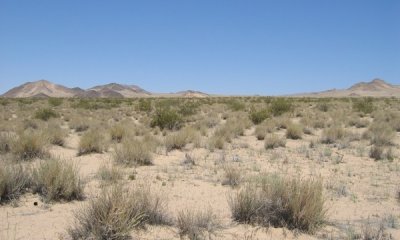
Hyperthermic Sandy Plains
Scenario model
Current ecosystem state
Select a state
Management practices/drivers
Select a transition or restoration pathway
- Transition 1 More details
- Transition 2 More details
-
No transition or restoration pathway between the selected states has been described
Target ecosystem state
Select a state
Description
State 1 represents the historic range of variability for this ecological site. This state no longer exists due to the ubiquitous naturalization of non-native species in the Mojave Desert. Periodic drought was the natural disturbance influencing this ecological site.
Data for this State does not exist, but dynamics and composition would have been similar to State 2, except with only native species present. See State 2 narrative for more detailed information.
Description
State 2 represents the current range of variability for this site. Non-native annuals, including Mediterranean grass and Asian mustard are naturalized in this plant community. Their abundance varies with precipitation, but they are at least sparsely present (as current year’s growth or present in the soil seedbank).
Submodel
Description
This State is characterized by the loss of sandsheet stability, with increased rates of wind erosion leading to deflation. This state has been significantly altered from the natural range of variability found in States 1 and 2. Increased wind erosion decreases the suitability of this ecological site for vegetation, killing established or recruiting individuals by abrasion and burial (Okin et al. 2001). Ongoing disturbance could result in complete loss of vegetation cover. Sand deflation could result in the accumulation of surface rock fragments, dramatically altering the soil and hydrological characteristics of this ecological site, and decreasing site suitability for annual species and big galleta. This is more of a risk with soils that have an alluvial influence such as the Sheephole series.
We do not have data for this State, and further research is necessary to describe the community phases and successional pathways that may exist within the state.
Mechanism
This transition occurred with the naturalization of non-native species in this ecological site. Non-native species were introduced with settlement of the Southwest Desert region in the 1860s.
Mechanism
This transition occurs with a loss of vegetation cover, in combination with drought and/or extreme wind conditions and/or anthropogenic disturbance such as off-road vehicle use that increases wind erosion beyond the threshold that will sustain the reference plant community. It is difficult to pinpoint the precise combination of these factors that will trigger this conversion (Cooke et al. 1993).
Model keys
Briefcase
Add ecological sites and Major Land Resource Areas to your briefcase by clicking on the briefcase (![]() ) icon wherever it occurs. Drag and drop items to reorder. Cookies are used to store briefcase items between browsing sessions. Because of this, the number of items that can be added to your briefcase is limited, and briefcase items added on one device and browser cannot be accessed from another device or browser. Users who do not wish to place cookies on their devices should not use the briefcase tool. Briefcase cookies serve no other purpose than described here and are deleted whenever browsing history is cleared.
) icon wherever it occurs. Drag and drop items to reorder. Cookies are used to store briefcase items between browsing sessions. Because of this, the number of items that can be added to your briefcase is limited, and briefcase items added on one device and browser cannot be accessed from another device or browser. Users who do not wish to place cookies on their devices should not use the briefcase tool. Briefcase cookies serve no other purpose than described here and are deleted whenever browsing history is cleared.
Ecological sites
Major Land Resource Areas
The Ecosystem Dynamics Interpretive Tool is an information system framework developed by the USDA-ARS Jornada Experimental Range, USDA Natural Resources Conservation Service, and New Mexico State University.
